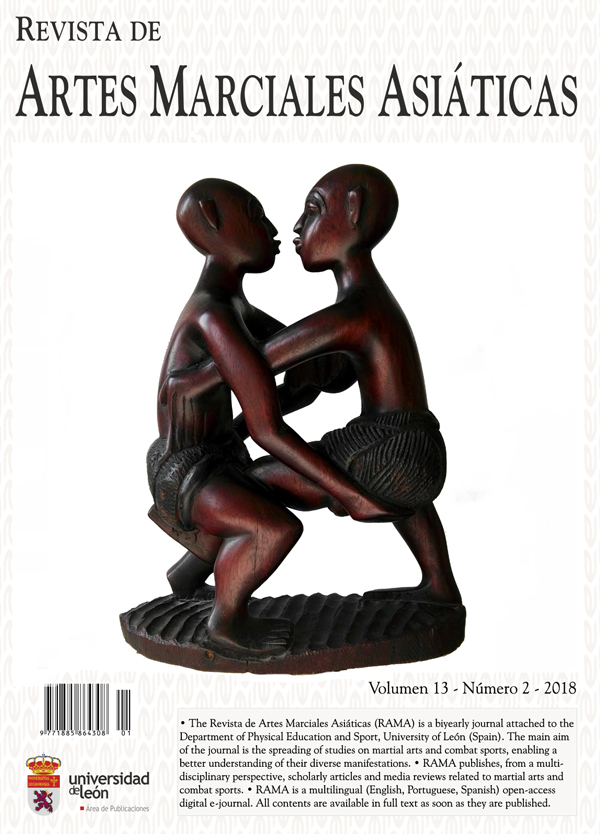Informe sobre la Conference for the 100th Anniversary of Choi Hong Hi: Taekwon-Do and Life; How to View Choi Hong Hi
DOI:
https://doi.org/10.18002/rama.v13i2.5628Palabras clave:
Taekwondo, Federación Internacional de Taekwon-Do, ITF, Complejo rojo, Fundación para la Promoción del Taekwondo, artes marciales, deportes de combateAgencias Financiadoras:
Keimyung University (grant #20180269)Resumen
El General Choi Hong Hi ha sido durante mucho tiempo una figura controvertida en la República de Corea (ROK; Corea del Sur), a pesar de su enorme influencia en el taekwondo. La “Conference for the 100th Anniversary of Choi Hong Hi: Taekwon-Do and Life; How to View Choi Hong Hi” se celebró el 28 de noviembre de 2018 en la Korea National Sport University. El presente informe sobre dicha conferencia tiene el propósito de difundir los hallazgos de los conferenciantes a una audiencia más amplia y establecer nuevas líneas de debate académico sobre el taekwondo de la Federación Internacional de Taekwon-Do (ITF). Esta conferencia también sacó a la luz algunos problemas existentes en la literatura sobre el taekwondo; a saber, que la literatura de la ITF está muy oscurecida debido a la investigación existente sobre su contraparte olímpica. Además, parece que el único órgano de gobierno del taekwondo de la ROK interesado en restablecer el legado del General Choi es la Fundación para la Promoción del Taekwondo. Sin embargo, aunque era un tema tabú en la ROK hace una década, el clima político existente en el país ha cambiado y el legado del General Choi está resurgiendo lentamente.
Descargas
Métricas alternativas
Citas
Adrogué, M. E. (2010). ITF Taekwon-Do & sine wave as “sequential motion”. Totally Tae Kwon Do, (15), 19-25.
Cho, M. (2007). From street corners to plaza: The production of festive civic space in Seoul. In M. Douglass, K. C. Ho & G. K. Ooi (eds.), Globalization, the City and Civil Society in Pacific Asia: The Social Production of Civic Spaces (Rethinking Globalizations) (pp. 194-210). London & New York: Routledge.
Choi, H. H. (1987). Encyclopedia of Taekwon-Do, volume 1 (3rd ed.). Mississauga, Canada: International Taekwon-Do Federation.
Choi, H. H. (c2000). Taekwon-Do and I, volume 2: the vision of exile: Any place under heaven is do-jang. N.p.: International Taekwon-Do Federation.
Gillis A. (2016). A killing art: The untold history of Tae Kwon Do – updated and revised edition (1st ed.). Toronto, Canada: ECW Press, Inc.
Heller J., Peric T., Dlouha R., Kohlikova E., Melichna J., & Novakova H. (1998). Physiological profiles of male and female Taekwondo (ITF) black belts. Journal of Sports Sciences, 16(3), 243-249. doi: http://doi.org/10.1080/026404198366768
Heo, I. U. (2015). The study of Taekwondo spirit before the 1960s. Taekwondo Journal of Kukkiwon, 6(1), 1-20.
Johnson, J. A., & Vitale, G. (2018). Taekwondo diplomacy: New possibilities for peace on the Korean Peninsula. Physical Activity Review, 6, 237-250. doi: http://doi.org/10.16926/par.2018.06.28
Kim D. H. (2018, Nov. 3). South and North Korea to integrate respective branches of Taekwondo. Hankyoreh. Retrieved from http://english.hani.co.kr/arti/english_edition/e_northkorea/868668.html?fbclid=IwAR1OOkM3tor9_MVLZMb0ms4gExcdT9Ro1FEjcy96KitKtY5ZWD85a3eHqEI
Kim, D. K., Kim, G. H., & Kim, Y. K. (2004). Choi, Hong Hi and Kim, Un Young’s Taekwondo philosophy and globalization strategy. Philosophy of Movement: The Journal of Korean Philosophic Society for Sport and Dance, 12(2), 363-383. [in Korean].
Korea Foundation. 2013. Taekwondo: The unity of body, mind and spirit. Seoul: Seoul Selection.
Moenig U. (2015). Taekwondo” from a martial art to a combat sport. New York, NY: Routledge.
Moenig U., Cho S., & Kwak T. Y. (2014). Evidence of Taekwondo’s roots in Karate: An analysis of the technical content of early Taekwondo literature. Korea Journal, 54(2), 150-178.
Nishiyama H., & Brown R. C. (1960). Karate: the art of “empty hand” fighting. North Clarendon, VT: Tuttle.
Wąsik J. (2007). The physical basis of the twimyo nomo yop chagi test in Taekwon-Do ITF. Archives of Budo, 3, 82-85.
Wąsik J. (2009). Structure of movement of a turning technique used in the event of special techniques in Taekwon-do ITF. Archives of Budo, 5, 111-115.
Wąsik J. (2011). Kinematics and kinetics of Taekwon-do side kick. Journal of Human Kinetics, 30, 13-20. doi: https://doi.org/10.2478/v10078-011-0068-z
Descargas
Publicado
Cómo citar
Número
Sección
Licencia
Derechos de autor 2018 John A. Johnson, Sanko Lewis

Esta obra está bajo una licencia internacional Creative Commons Atribución-NoComercial-CompartirIgual 4.0.
Los autores que publican en esta revista están de acuerdo con los siguientes términos:
- Los autores ceden de forma no exclusiva los derechos de explotación (reproducción, distribución, comunicación pública, transformación) a la Universidad de León, por lo que pueden establecer, por separado, acuerdos adicionales para la distribución no exclusiva de la versión de la obra publicada en la revista (por ejemplo, alojarlo en un repositorio institucional o publicarlo en un libro), con un reconocimiento de su publicación inicial en esta revista.
- Este trabajo se encuentra bajo la Creative Commons Attribution-NonCommercial-ShareAlike 4.0 International License. Puede consultarse desde aquí la versión informativa y el texto legal de la licencia.
- Se permite y se anima a los autores a difundir electrónicamente las versiones pre-print (versión antes de ser evaluada) y/o post-print (versión evaluada y aceptada para su publicación) de sus obras antes de su publicación, ya que favorece su circulación y difusión más temprana y con ello un posible aumento en su citación y alcance entre la comunidad académica.











